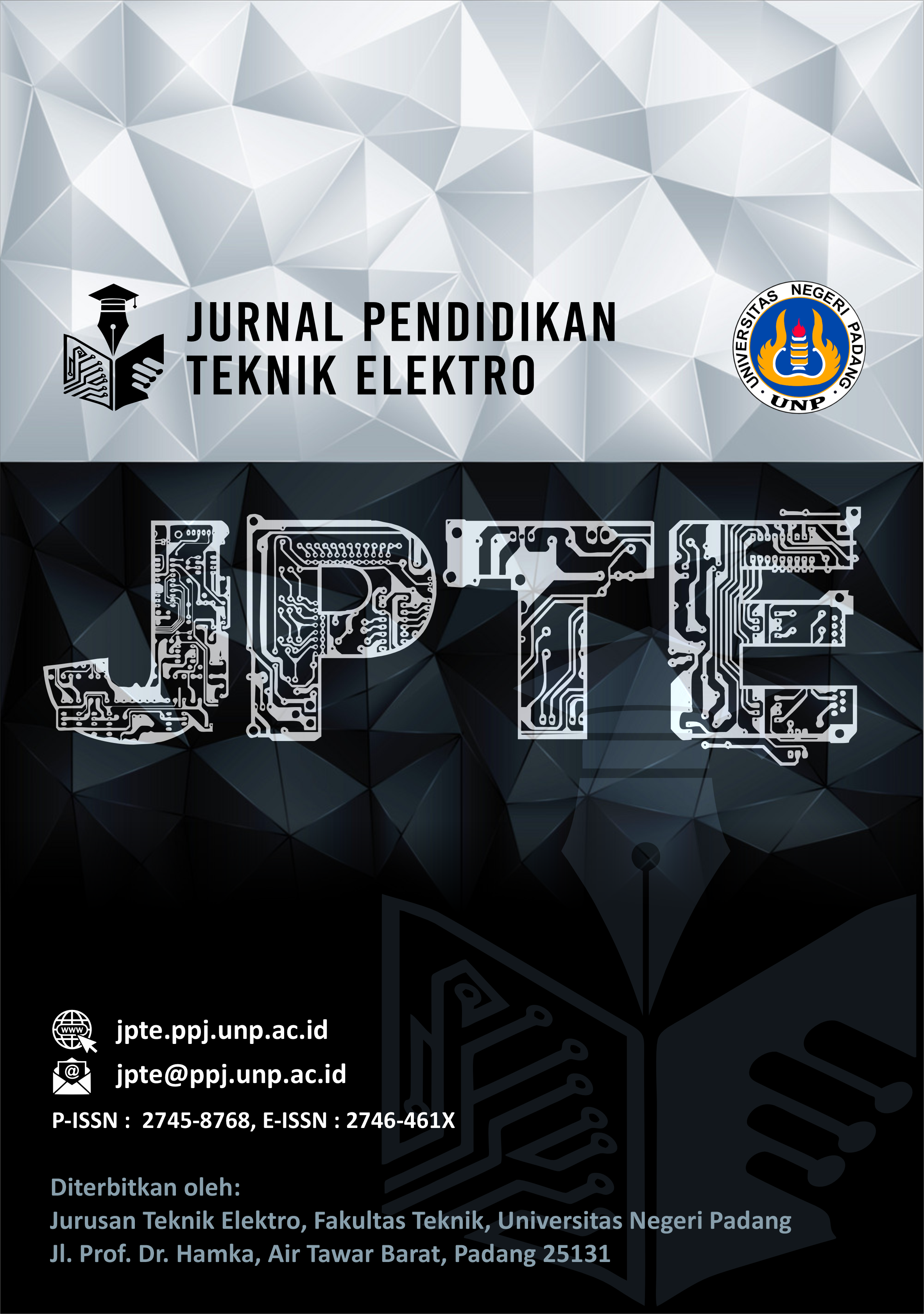Perbedaan Hasil Belajar Fisika Teknik Mahasiswa Program tudi Pendidikan Teknik Elektro Berdasarkan Latar Belakang Pendidikan dan Jalur Masuk Perkuliahan
##plugins.themes.academic_pro.article.main##
Abstract
This study was motivated by the low learning achievement of students in the Engineering Physics course, as evidenced by the fact that there are still students who get an E (failed) in the Engineering Physics course. Students with a vocational high school educational background also tend to have a higher percentage of failures than high school and MA. This study aims to analyze the differences in learning achievement of the Engineering Physics course of students of the Electrical Engineering Education Study Program, Padang State University, class of 2020, based on educational background (SMA, SMK, MA) and college entrance pathways (SNMPTN, SBMPTN, Mandiri). This study uses a quantitative method with a comparative approach. Data were obtained through documentation of students' Engineering Physics course grades, which were analyzed using descriptive and inferential statistical techniques. The results of the study showed that there were significant differences in the learning achievement of the Engineering Physics course of students of the Electrical Engineering Education study program based on educational background. This difference was seen in students with a vocational high school educational background and students with a high school educational background. However, no significant differences were found based on college entrance pathways.
##plugins.themes.academic_pro.article.details##

This work is licensed under a Creative Commons Attribution 4.0 International License.
References
[2] N. A. Fitriani, U. N. Makassar, M. A. Martawijaya, U. N. Makassar, U. N. Makassar, and P. Korespondensi, “ANALISIS KONSEP FISIKA MAHASISWA TEKNIK ELEKTRONIKA,” no. 1, pp. 17–23, 2024.
[3] Y. Efronia and R. Mukhaiyar, “Kompetensi Dasar dari Kurikulum Prodi Pendidikan Teknik Elektro Universitas Negeri Padang,” JTEV (Jurnal Tek. Elektro dan Vokasional), vol. 6, no. 1, p. 179, 2020, doi: 10.24036/jtev.v6i1.107861.
[4] K. R. Suwena, “Jalur Penerimaan Mahasiswa Baru Bukan Penentu Prestasi Belajar Mahasiswa,” Ekuitas J. Pendidik. Ekon., vol. 5, no. 2, pp. 1–10, 2017, doi: 10.23887/ekuitas.v5i2.12749.
[5] M. Pendidikan, D. A. N. Kebudayaan, and R. Indonesia, “Peraturan Menteri Pendidikan Dan Kebudayaan Nomor 03 Tahun 2020 Tentang Standar Nasional Perguruan Tinggi,” no. 47, 2020.
[6] N. Hasnunidah, “Metodologi Penelitian Pendidikan,” Media Akad., p. 117, 2017.
[7] Soegiyono, Metode Penelitian Kuantitatif, Kualitatif dan R&D. 2011.
[8] Syahrum and Salim, METODOLOGI PENELITIAN KUANTITATIF.pdf. Bandung: Citapustaka Media, 2012.
[9] J. Kloke and J. McKean, “Nonparametric statistical methods using R,” Nonparametric Stat. Methods Using R, pp. 1–447, 2024, doi: 10.1201/9781003039617.
[10] F. H. Afifi, H. D. Saputra, M. Nasir, and D. S. Putra, “Perbandingan Hasil Belajar Tamatan SMA dan SMK, Studi Kasus pada Mahasiswa Teknik Otomotif Fakultas Teknik Universitas Negeri Padang,” MSI Trans. Educ., vol. 4, no. 1, pp. 13–22, 2023, [Online]. Available: http://www.msirp.org/journal/index.php/mted/article/view/104
[11] S. Sihite, “Analysis Comparative of Learning Outcomes College Student By Entrance in Higher Education in Economic Education Forces 2012 Dan 2013 Mahasiswa Pendidikan Ekonomi,” pp. 1–15, 2013.
[12] A. G. Rahman, R. Refdinal, H. Nurdin, and P. Primawati, “Perbedaan Hasil Belajar Mahasiswa Berdasarkan Jalur Masuk Dan Asal Sekolah Pada Mata Kuliah Matematika Di Jurusan Teknik Mesin Ft-Unp,” J. Vokasi Mek., vol. 4, no. 1, pp. 163–168, 2022, doi: 10.24036/vomek.v4i1.326.
[13] Y. Wikarya, “Komparasi Hasil Belajar Mahasiswa FBS UNP Padang Berdasarkan Jalur Masuk Perguruan Tinggi,” Komposisi J. Pendidik. Bahasa, Sastra, dan Seni, vol. 12, no. 2, 2011, doi: 10.24036/komposisi.v12i2.3923.
[14] M. Idris, “Analisis Prestasi Akademik Mahasiswa Teknik Informatika Institut Teknologi Sumatera (ITERA) Berdasarkan Jalur Seleksi Masuk Perguruan Tinggi Negeri,” J. Sci. Appl. Technol., vol. 5, no. 1, p. 126, 2021, doi: 10.35472/jsat.v5i1.410.
[15] P. I. Mawarni, “Perbandingan Hasil Belajar Akuntansi Mahasiswa Pendidikan Akuntansi Universitas Negeri Surabaya Ditinjau Dari Latar Belakang Pendidikan dan Jalur Seleksi Masuk Perguruan Tinggi,” J. Pendidik. Akutansi, vol. 01, no. 1, pp. 1–6, 2017.

